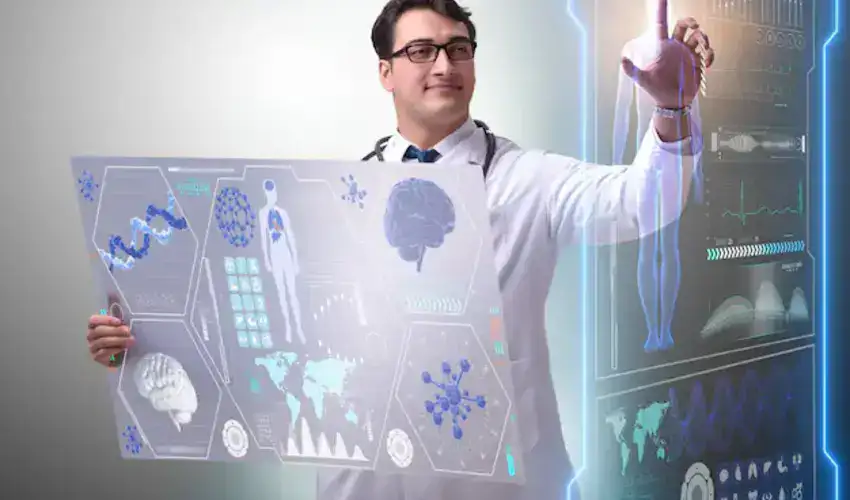A healthcare virtual assistant is someone who functions from a remote location and can assist you with daily tasks like typing documents, sending out invoices, and client communication. As the healthcare system expands, doctors are also attaining more work to conduct routine tasks.
Introduction
Encountering continuous staff scarcity and expanding patient demand, healthcare companies around the globe are being forced to reconsider where and how they deliver care. There is also recognition of the significance of decreasing the sector’s environmental influence.
These 5 healthcare technology trends highlight the possibility of innovation to assist enhanced care to more people in a sustainable technique.
Gen AI: A Time-Saving Healthcare Virtual Assistant
Healthcare leaders are turning to automation to decrease the burden on healthcare experts. The 2024 Philips Future Health Index report demonstrated that 92% of graphed healthcare leaders consider automation significant for addressing staff shortages by discharging them from repetitive processes and tasks. An equal percentage consider that it will save time for healthcare experts by decreasing administrative work. This permits them to allocate more time to patients.
Currently, gen AI can work as a virtual assistant to save healthcare experts valuable time, utilizing large language frameworks to streamline clinical notes. This simplifies the techniques through which the information of the patients is communicated across the teams.
Simplifying Difficult Diagnostic With Artificial Intelligence (AI)
AI can importantly organize administrative tasks and enhance patient engagement, its role in healthcare outspreads beyond automation. AI can also raise the skills of healthcare experts. With experienced staff in short supply in numerous healthcare systems around the globe, AI can assist in simplifying difficult diagnoses, allowing lesser experienced experts to offer superior quality with confidence.
Incorporating AI into the treatment of cancer can improve patient care by addressing the increased heart disease risk. It is associated with therapies like chemotherapies and radiation. Studies demonstrate that adult cancer survivors across an extensive variety of cancers encounter a 37% higher risk of creating cardiovascular disease. The latest AI technologies can rapidly pinpoint signs of cardiotoxicity early in the treatment procedure by accelerating and automating echocardiographic measurements. Enhanced reproducibility and lesser study times make the procedure reliable and efficient. It decreases the risk of treatment delays. This is the good news for cancer patients who otherwise encounter serious heart problems along with recovery.
Creating Resilient Healthcare Systems Incorporating Technology To Adapt To Changes In The Climate
Climate change poses increasingly important challenges. There is an urgent requirement for healthcare systems and hospitals to improve their readiness. The World Health Organization reports that climate change is currently affecting health in different ways, entailing illnesses and death from heat waves, wildfires, floods, and drought. Majority of the healthcare facilities witness a rising number of patient climate-relevant health issues. Problems extend beyond patient care-healthcare must also consider the effect on their facilities and operations.
Collaborations To Decrease Supply Chain Releases
The huge majority of healthcare’s carbon footprint i.e. 71% comes from the supply chain via the disposal, transport, and production of goods and services. Decreasing these emissions is anticipated to have 7 times more effect than just decreasing an organization’s emissions. Healthcare companies are increasingly recognizing the significance of addressing the supply chain emissions not only for future government regulations and decreasing the entire environmental effect but also for their financial performance. They are teaming up with partners during their value chain to drive transformation.
Digital Health and Data Are Generating Tech-Savy Parenting
Start modern-day parenting on quite a digital tangent with smart gadgets and children in complexes; It has now opened up previously unavailable gates to data that enable parents to make informed decisions as well as receive reassurance about the state of their child’s health and general welfare. There is a developing curiosity about AI-enabling technologies that offer monitoring and predictive insight into behavioral characteristics over and above just monitoring the child.
Frequently Asked Questions (FAQs)
What is a healthcare virtual assistant?
A healthcare virtual assistant is someone who functions from a remote location and can assist you with daily tasks like typing documents, sending out invoices, and client communication. As the healthcare system expands, doctors are also attaining more work to conduct routine tasks.
How gen AI healthcare virtual assistants save time for doctors?
Healthcare leaders are turning to automation to decrease the burden on healthcare experts. An equal percentage consider that it will save time for healthcare experts by decreasing administrative work. This permits them to allocate more time to patients. Currently, gen AI can work as a virtual assistant to save healthcare experts valuable time, utilizing large language frameworks to streamline clinical notes. This simplifies the techniques through which the information of the patients is communicated across the teams.

